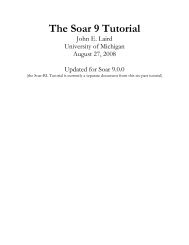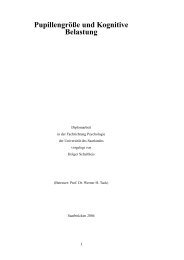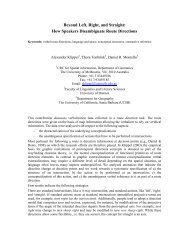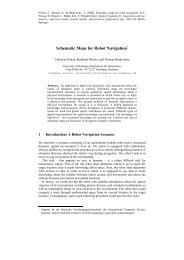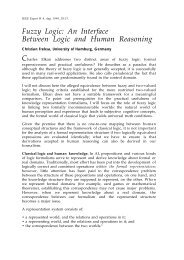SparQ: A Toolbox for Qualitative Spatial Representation and ...
SparQ: A Toolbox for Qualitative Spatial Representation and ...
SparQ: A Toolbox for Qualitative Spatial Representation and ...
You also want an ePaper? Increase the reach of your titles
YUMPU automatically turns print PDFs into web optimized ePapers that Google loves.
Here the result is a disjunction of 10 base relations. It is also possible to have<br />
disjunctions of base relations as input parameters. For instance, the following<br />
call computes the intersection of two disjunctions:<br />
$ ./sparq compute-relation dra-24 intersection "(rrrr rrll rllr)"<br />
"(llll rrll)"<br />
> (rrll)<br />
3.3 Constraint reasoning<br />
The constraint-reasoning module reads a description of a constraint network—<br />
which is a qualitative scene description that may include disjunctions <strong>and</strong> may<br />
be inconsistent <strong>and</strong>/or underspecified—<strong>and</strong> per<strong>for</strong>ms a particular kind of consistency<br />
check 8 . Which type of consistency check is executed depends on the first<br />
module specific parameter:<br />
action The two actions currently provided are ‘path-consistency’ <strong>and</strong> ‘scenarioconsistency’<br />
<strong>and</strong> determine which kind of consistency check is per<strong>for</strong>med.<br />
The action ‘path-consistency’ causes the module to en<strong>for</strong>ce path-consistency on<br />
the constraint network using van Beek’s algorithm [18] or detect the inconsistency<br />
of the network in the process. We could <strong>for</strong> instance check if the scene<br />
description generated by the qualify module in section 3.1 is path-consistent<br />
which of course it is. To make it slightly more interesting we add the base relation<br />
ells to the constraint between A <strong>and</strong> C resulting in a constraint network<br />
that is not path-consistent:<br />
$ ./sparq constraint-reasoning dra-24 path-consistency<br />
$ ( (A rllr B) (A (ells rllr) C) (B lrrl C) )<br />
> Modified network.<br />
> ( (B (lrrl) C) (A (rllr) C) (A (rllr) B) )<br />
The result is a path-consistent constraint network in which ells has been removed.<br />
The output ‘Modified network’ indicates that the original network was not pathconsistent<br />
<strong>and</strong> had to be changed. Otherwise, the result would have started with<br />
‘Unmodified network’. In the next example we remove the relation rllr from the<br />
disjunction between A <strong>and</strong> C. This results in a constraint network that cannot<br />
be made path-consistent which implies that it is not globally consistent.<br />
$ ./sparq constraint-reasoning dra-24 path-consistency<br />
$ ( (A rllr B) (A ells C) (B lrrl C) )<br />
> Not consistent.<br />
> ( (B (lrrl) C) (A () C) (A (rllr) B) )<br />
8 The constraint-reasoning module also provides some basic actions to manipulate<br />
constraint networks that are not further explained in this text. One example is the<br />
‘merge’ operation that is used in the example in section 5.



